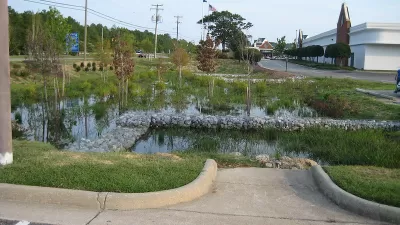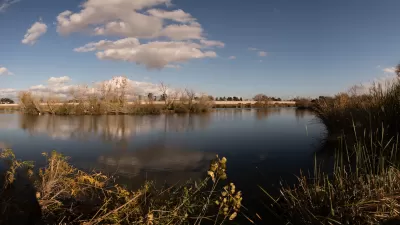Green infrastructure can help prevent flooding and replenish groundwater supplies, preventing subsidence that makes land sink.

According to an article by Matt Simon in Wired, U.S. cities could be capturing tens of billions of gallons of rainwater with more ‘spongy’ infrastructure.
A new report from the Pacific Institute indicates that urban areas generate almost 60 million acre-feet of stormwater runoff per year — much of which is diverted away from cities and into the ocean or other bodies of water. Reversing this approach to capture rainwater could help replenish groundwater resources and secure local water supplies.
Simon points to a recent report that Los Angeles captured 8.6 billion gallons of water in recent storms through a combination of green infrastructure methods. On the East Coast, cities are working to mitigate flooding through rain gardens, bioswales, and permeable pavement. “More cities are also adopting stormwater fees, charging landowners based on the amount of impervious surfaces on a property, thus encouraging them to open up more ground.”
FULL STORY: US Cities Could Be Capturing Billions of Gallons of Rain a Day

Alabama: Trump Terminates Settlements for Black Communities Harmed By Raw Sewage
Trump deemed the landmark civil rights agreement “illegal DEI and environmental justice policy.”

Planetizen Federal Action Tracker
A weekly monitor of how Trump’s orders and actions are impacting planners and planning in America.

Why Should We Subsidize Public Transportation?
Many public transit agencies face financial stress due to rising costs, declining fare revenue, and declining subsidies. Transit advocates must provide a strong business case for increasing public transit funding.

Understanding Road Diets
An explainer from Momentum highlights the advantages of reducing vehicle lanes in favor of more bike, transit, and pedestrian infrastructure.

New California Law Regulates Warehouse Pollution
A new law tightens building and emissions regulations for large distribution warehouses to mitigate air pollution and traffic in surrounding communities.

Phoenix Announces Opening Date for Light Rail Extension
The South Central extension will connect South Phoenix to downtown and other major hubs starting on June 7.
Urban Design for Planners 1: Software Tools
This six-course series explores essential urban design concepts using open source software and equips planners with the tools they need to participate fully in the urban design process.
Planning for Universal Design
Learn the tools for implementing Universal Design in planning regulations.
Caltrans
Smith Gee Studio
Institute for Housing and Urban Development Studies (IHS)
City of Grandview
Harvard GSD Executive Education
Toledo-Lucas County Plan Commissions
Salt Lake City
NYU Wagner Graduate School of Public Service





























